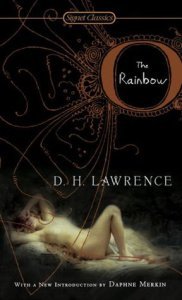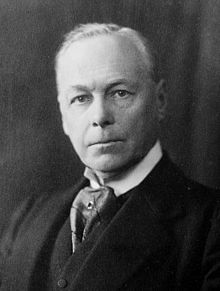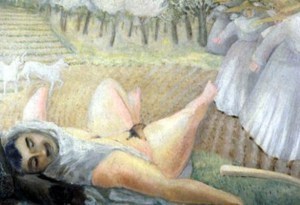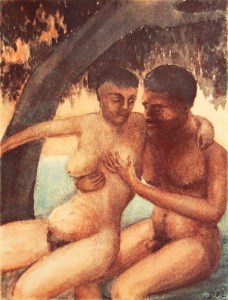The Hounding of D.H. Lawrence, Smuthound(?)
Our topic of conversation today: D.H. Lawrence [Nottingham].
In our last entry, we discussed how the 1857 Obscene Publications Act affected both scientific research and literature in the twentieth century. The result of the OPA and the government’s use of it was sweeping and chilling, and it resulted in most authors and speakers self-censoring or being forced to by their publishers. On the other end of the spectrum was a writer that declared outright contempt for and war upon the Obscene Publications Act: D.H. Lawrence. The near-hounding of Lawrence by the Home Office, newspaper critics, and moral societies from the 1915 burning of The Rainbow to the posthumous trial (1960) of Lady Chatterley’s Lover (1929) was tantamount to decades-long governmental crusade against him. Lawrence responded with a campaign of his own by continuing to write and by targeting English censors with vitriol in poetry such as Nettles (1930) and in pamphlets such as Pornography and Obscenity (1929), which will be examined below.The government became ‘aware’ of Lawrence in 1915, the middle of World War I, where his publication of The Rainbow was immediately met with newspaper criticism of its frank discussion of sex. The Rainbow is a family history of three generations of the Brangwen family, beginning with Tom Brangwen falling in love with Lydia, a Polish refugee. The next section of the book concerns the tumultuous relationship between Lydia’s daughter Anna and her husband Will. However, the vast majority of the book—over three-quarters of it—is focused on Anna and Will’s daughter, Ursula. The Rainbow focuses intently on the subtle politics of relationships, at the expense of all else. This is apparent from the first chapter, “How Tom Brangwen Married a Polish Lady,” to the last pages of the novel, where Ursula dwells on a lost lover. Lawrence’s novel is a study of love, a word that is repeated over a hundred times in it, and seems to crop up every ten pages.
Please be aware that some of the text/images below the fold may be NSFW (not safe for work).

Signet Classics’ edition of The Rainbow
Specifically, The Rainbow focuses on the tensions between love, lust, and power. Both Lydia and Anna ‘give in’ to men and masculine lust, which is described as uncontrollable: when Anna rejects Will’s advances he “became a mad creature, black and electric with fury. The dark storms rose in him, his eyes glowed black and evil,” and he “force[s] his will upon her.” Lydia is erased by Tom, but Anna, who represents a transition from absolute patriarchy, is not completely powerless: when Will had finished “getting his satisfaction of her” she “strikes back,” dashing, goading, harassing him (in her words), until he “recognized her as the enemy.” The tempestuous war between the two of them continues, alternating between intense hostility and overwhelming love, until they are complete strangers to each other. Only then, when they treat each other as equals are they transformed:
He was the sensual male seeing his pleasure, she was the female ready to take hers: but in her own way. . . She was another woman under the instance of a strange man. He was a stranger to her, seeing his own ends. Very good. . .They abandoned in one motion the moral position, each was seeing gratification pure and simple. . .he lived in a passion of sensual discovery with her.
The battle between the pair is essentially a conflict over love and power, over the need for control and dominance in the relationship. Whereas Lydia was essentially controlled and dominated by her husband, Anna and Will, alienated from each other over the course of years, manage to have a rapprochement by finally seeing each other as equals and taking what they want from each other.
If the visceral descriptions were not disturbing to censors, the account of Ursula’s life, which takes up most of the book was undoubtedly so. Representing (to Lawrence) the most important and modern generation in the Brangwen family, Ursula is the first woman who has the freedom to choose between love and power, to control or refuse the masculine lust that is foisted upon her, or even pursue alternate routes. For example, when she begins a relationship with Anton Skrebensky, a British soldier, she does not ‘give in’ to his entreaties or physical goading:
He appropriated her. There was a fierce, white cold passion in her heart. . .like a soft weight upon her, bearing her down. . . but still her body was the subdued, cold, indomitable passion. . . She received all the force of his power. . . She was cold and unmoved as a pillar of salt.
Despite the fact that his “will was set and straining with all its tension,” he is “annihilated” and her pillar of salt “burn[s] and corrod[es]” him. Under a patriarchal system, the two fates for women were supposed to be marriage and reward or whoredom and punishment—Lawrence’s Ursula subverts both of these. When Anton returns from fighting the Boer War years later, the pair end up getting engaged and having sex. However, Ursula abruptly decides that “’I don’t think I want to marry you [Anton]… I don’t want to be with other people’ she said. ‘I want to be like this. I’ll tell you if ever I want to marry you.’” Anton breaks off their engagement, marries another woman, and sails for India, and Ursula finds that she is pregnant. Disaster for the whore seems to loom—but it never manifests, as Ursula miscarries, and then carries on with her life, stronger than before—she becomes the protagonist of Lawrence’s next novel, Women In Love (1920).

Sir William Joynson-Hicks, 1st Viscount Brentford, who made it his life’s goal to hound Lawrence.
On top of Ursula’s subversions and Lawrence’s descriptions, two final nails would drive the coffin shut for a censorship case: Ursula’s lesbian relationship with her teacher, Ms. Iver, and the questioning of Christianity by various characters. Ursula’s relationship with Ms. Iver was not subtle—Lawrence describes it even more openly than some of his heterosexual relationships, and they indeed “become intimate.” Furthermore, both Ms. Inger and Anna question Christianity; Ms. Inger saying that “religions were local [but] Religion was universal. Christianity was a local branch,” and Anna saying “It is impudence to say that Woman was made out of Man’s body, when every man is born of a woman.” Regardless of which particular alerted or disturbed them, the police were quick to obtain a warrant under the 1857 Obscene Publications Act and seize all copies of The Rainbow for destruction. Like Ellis, they targeted the publisher of the novel, Methuen, and forced them to renounce the book and burn all copies. The publisher was not happy as they had attempted to get Lawrence to “moderate the manuscript and he had twice refused.” The case led to a blacklisting of Lawrence in England, its colonies, and America—the Home Office and others would go after his Women in Love, Lady Chatterley’s Lover, and his other novels, poetry and plays—he was even forced to use a pseudonym (Lawrence H. Davidson) on textbooks he wrote, to avoid scrutiny.
Admirably or foolishly, Lawrence never changed his focus or declined an opportunity to attack his censorial adversaries. For example, when he published a book of poetry, Pansies (1928), Scotland Yard demanded that he remove 12 controversial poems or face prosecution, which he did, saying they were “not terribly important bits.” However, using the publicity he secretly printed 500 copies of the original book, with the offending poems added back in, but for ‘private’ publication only. When they had all sold, he announced this through his publisher, who said that “in the event of any action taken, which I do not consider likely, it would have to be proved that the book was likely to fall into the hands of people who were liable to be morally influenced by it.” Lawrence was well-aware of the distinction between the original 1857 Act and the Hicklin Test, and knew he had a good case if it were to go to trial. Indeed, it seems that he deliberately instigated the authorities in hope of this. Unfortunately for Lawrence, the Director of Public Prosecutions was also well-aware of the distinction, and refused to proceed in the issue, even if the Home Office wanted to pursue editions sent overseas.

One of Lawrence’s paintings that were seized.
Lawrence’s name alone seemed to be enough to bring down the police—an exhibition of his paintings in 1929 caused the police to dig up an even earlier act, the 1842 Vagrancy Act, in order to charge the gallery owner, Mr. St. John Hutchinson, with exhibiting indecent prints. When he appeared before the magistrates, Hutchinson argued that “the raid amounted to a new form of censorship. ‘I have not been able to find any case in which serious paintings have

Another Lawrence Painting that was seized.
been brought into a police court and a magistrate has been asked to decide whether they were obscene.’” Whether or not the magistrate was in agreement, he said he would dismiss the case if Hutchinson would agree to pay a fine of five pounds, which he agreed to, not willing to risk further prosecution as Lawrence may have been. The whole episode particularly enraged Lawrence, and he quickly responded to the trial with his landmark pamphlet/essay, Pornography and Obscenity (1929), where he noted that “when the police raided my picture show, they did not in the least know what to take. So they took every picture where the smallest bit of the sex organ of either man or woman showed.”
Pornography and Obscenity serves as a very useful insight into Lawrence’s understandings of sex and sexuality, and his use of them in his novels. He begins the essay by stating “what they [pornography and obscenity] are depends, as usual, entirely on the individual.” Noting that pornography means “the graph of the harlot” and obscene meant “that which might not be represented on stage” he points out the same issue that Lord Lyndhurst did a half-century earlier: “what is obscene to Tom is not obscene to Lucy or Joe.” In Lawrence’s view, it is mob-rule and mob-understanding that decide the obscene “Vox Populi, Vox Dei, don’t you know. If you don’t we’ll let you know it.” But Lawrence suggests a shift for the popular understanding of pornography, because

Cover of Pornography and Obscenity
even I would censor genuine pornography, rigorously. . .what is pornography, after all this? It isn’t sex appeal or sex stimulus in art. It isn’t even a deliberate intention on the part of the artist to arouse or excite sexual feelings. There’s nothing wrong with sexual feelings in themselves, so long as they are straightforward and not sneaking or sly. . .Pornography is the attempt to insult sex, to do dirt on it. This is unpardonable.
The ‘grey elderly ones’ that Lawrence targeted were, in his eyes, responsible for putting dirt on sex and love. As he would say in his Apropos of Lady Chatterley’s Lover: “I want men and women to be able to think sex, fully, completely, honestly, and cleanly. Even if we can’t act sexually to out complete satisfaction, let us at least think sexually, complete and clear.” The police and the censors that called them out were “the grey elderly ones” that “belong[ed] to the last century, the eunuch century… the century that has tried to destroy humanity, the nineteenth century…of purity and the dirty little secret.” Sexuality and its artistic representation, the last barrier in polite conversation and public discourse, was the battleground on which Lawrence fought for the right to express himself.
However, he was repeatedly stymied by a prosecutorial strategy that targeted publishers or gallery owners who were not willing to risk a full trial. As a result, Lawrence was left with an unwarranted reputation as a pornographer and nearly chased out of Britain by the end of WWI. A long period of self-imposed exile compounded by ill health and his death in 1930 left him unable to challenge the reputation in court, and he did not live to see the turning point in his struggle.
Sources:
[1] The Rainbow, D.H. Lawrence
[3] Lady Chatterley’s Lover,D.H. Lawrence

![Our topic of conversation today: D.H. Lawrence [Nottingham].](https://i.gr-assets.com/images/S/compressed.photo.goodreads.com/hostedimages/1457112146i/18321541.jpg)


